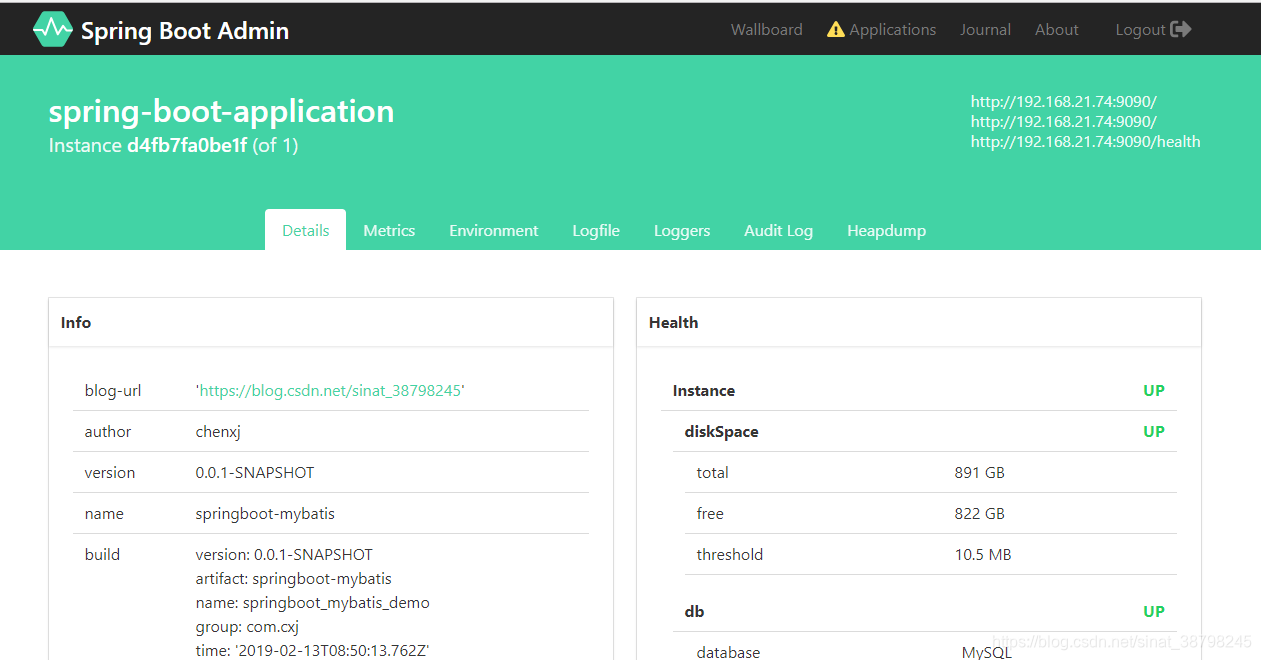SBA的诞生原因
上篇文章介绍了actuator的作用,细心的朋友可能会发现通过http restful api的方式查看信息过于繁琐也不够直观,效率低下,运维人员看到JSON数据更是一脸懵逼,这时强大的SBA就出现了
SBA是什么
SBA 全称 Spring Boot Admin是一个可视化的管理和监控SpringBoot应用程序的开源项目。分为admin-server与admin-client两个组件,admin-server通过采集actuator端点数据,显示在spring-boot-admin-ui上,已知的端点几乎都有进行采集,通过spring-boot-admin可以动态切换日志级别、导出日志、导出heapdump、监控各项指标等等….
先看效果图

怎么实现
第一步,添加依赖
<!-- 服务端:带UI界面 -->
<dependency>
<groupId>de.codecentric</groupId>
<artifactId>spring-boot-admin-starter-server</artifactId>
<version>2.0.0</version>
</dependency>
<!-- 客户端包 -->
<dependency>
<groupId>de.codecentric</groupId>
<artifactId>spring-boot-admin-starter-client</artifactId>
<version>2.0.0</version>
</dependency>
<!-- 使用actuator对springboot监控 -->
<dependency>
<groupId>org.springframework.boot</groupId>
<artifactId>spring-boot-starter-actuator</artifactId>
</dependency>
<!-- 安全认证 -->
<dependency>
<groupId>org.springframework.boot</groupId>
<artifactId>spring-boot-starter-security</artifactId>
</dependency>
<!-- 在管理界面中与 JMX-beans 进行交互所需要被依赖的 JAR -->
<dependency>
<groupId>org.jolokia</groupId>
<artifactId>jolokia-core</artifactId>
</dependency>
如果要访问info接口想获取maven中的属性内容请记得添加如下内容
<build>
<plugins>
<plugin>
<groupId>org.springframework.boot</groupId>
<artifactId>spring-boot-maven-plugin</artifactId>
<executions>
<execution>
<goals>
<goal>build-info</goal>
</goals>
</execution>
</executions>
</plugin>
</plugins>
</build>
第二步:配置文件
application.properties配置
# 描述信息
info.blog-url=https://blog.csdn.net/sinat_38798245
info.author=chenxj
[email protected]@
[email protected]@
# 选择激活对应环境的配置,如果是dev则代表不用认证就能访问监控页,prod代表需要认证
spring.profiles.active=prod
# 加载所有的端点/默认只加载了 info / health
management.endpoints.web.exposure.include=*
# 比较重要,默认 /actuator spring-boot-admin 扫描不到
management.endpoints.web.base-path=/
management.endpoint.health.show-details=always
# 可以关闭制定的端点
management.endpoint.shutdown.enabled=false
# 日志文件
logging.file=./target/admin-server.log
spring.boot.admin.client.url=http://localhost:${server.port}
# 不配置老喜欢用主机名,看着不舒服....
spring.boot.admin.client.instance.prefer-ip=true
application-prod.properties配置
# 登陆所需的账号密码
spring.security.user.name=chenxj
spring.security.user.password=123456
# 便于客户端可以在受保护的服务器上注册api
spring.boot.admin.client.username=chenxj
spring.boot.admin.client.password=123456
# 便服务器可以访问受保护的客户端端点
spring.boot.admin.client.instance.metadata.user.name=chenxj
spring.boot.admin.client.instance.metadata.user.password=123456
第三步:启动监控服务端
启动类上面添加上@EnableAdminServer注解即代表是Server端,集成UI的
/**
* prod 环境加载
*/
@Profile("prod")
@Configuration
public static class SecuritySecureConfig extends WebSecurityConfigurerAdapter {
private final String adminContextPath;
public SecuritySecureConfig(AdminServerProperties adminServerProperties) {
this.adminContextPath = adminServerProperties.getContextPath();
}
@Override
protected void configure(HttpSecurity http) throws Exception {
SavedRequestAwareAuthenticationSuccessHandler successHandler = new SavedRequestAwareAuthenticationSuccessHandler();
successHandler.setTargetUrlParameter("redirectTo");
http.authorizeRequests()
.antMatchers(adminContextPath + "/assets/**").permitAll()
.antMatchers(adminContextPath + "/login").permitAll()
.anyRequest().authenticated()
.and()
.formLogin().loginPage(adminContextPath + "/login").successHandler(successHandler).and()
.logout().logoutUrl(adminContextPath + "/logout").and()
.httpBasic().and()
.csrf().disable();
}
}